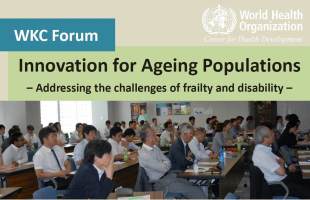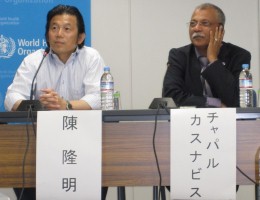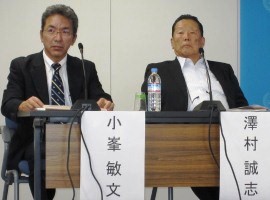WKC Forum report: Innovation for Ageing Populations – Addressing the challenges of frailty and disability –

“Total innovative solutions addressing the challenges faced by ageing populations call for integrated medical, technological and social innovations that are universally accessible.” This was the concluding message of Mr Chapal Khasnabis, Technical Officer, WHO HQ Disability and Rehabilitation, Violence and Injury Prevention and Disability during his presentation at the WHO Centre for Health Development (WHO Kobe Centre - WKC) Forum held on 24 June 2014 in Kobe, Japan. Speaking to 76 participants coming from multiple sectors (i.e., hospitals/clinics, industry, research, universities, local governments, etc.), he presented an “Overview about innovative assistive technology for ageing populations: addressing frailty and disability” where he discussed the need for age-sensitive and knowledgeable, multi-skilled health service providers. He stressed the need for a paradigm shift in mindset as well as strategic processes that would result to assistive health products being: 1) available and accessible to communities; and 2) affordable, no matter who pays for
 Dr Takaaki Chin, President, International Society for Prosthetics and Orthotics (ISPO), Japan, who focused on “Prosthetic walking for older lower limb amputees” introduced at first that the number of lower limb amputations globally for older populations has increased in recent years with critical limb ischemia as the cause secondary to peripheral circulatory failure due to arteriosclerosis and diabetes. Dr Chin is also the Director, Hyogo Institute of Assistive Technology (HIAT), Japan and Director, Robotic Rehabilitation Center of the Hyogo Rehabilitation Center, Japan. He stated that in Japan, there are 4000 reported cases of lower limb major amputations per year with two main challenges - improving the rate of preserving the knee joint and improving the success rate of rehabilitation post-amputation. In order to walk with prosthesis, older lower limb amputees must possess the following requirements: 1) motivation or the strong will to walk; 2) ability to put on (“don”) and take off (“doff”) the prosthesis which means in effect having good upper limb functions; 3) maintain standing position; and 4) physical strength for walking.
Dr Takaaki Chin, President, International Society for Prosthetics and Orthotics (ISPO), Japan, who focused on “Prosthetic walking for older lower limb amputees” introduced at first that the number of lower limb amputations globally for older populations has increased in recent years with critical limb ischemia as the cause secondary to peripheral circulatory failure due to arteriosclerosis and diabetes. Dr Chin is also the Director, Hyogo Institute of Assistive Technology (HIAT), Japan and Director, Robotic Rehabilitation Center of the Hyogo Rehabilitation Center, Japan. He stated that in Japan, there are 4000 reported cases of lower limb major amputations per year with two main challenges - improving the rate of preserving the knee joint and improving the success rate of rehabilitation post-amputation. In order to walk with prosthesis, older lower limb amputees must possess the following requirements: 1) motivation or the strong will to walk; 2) ability to put on (“don”) and take off (“doff”) the prosthesis which means in effect having good upper limb functions; 3) maintain standing position; and 4) physical strength for walking.
“The amputees are my teachers and the communities are my textbooks,” sagely narrated Dr Seishi Sawamura, Principal and Honorary Director of the Hyogo Rehabilitation Center, Japan, who spoke about “A short history of prosthetics and orthotics in Japan: Lessons gained from organizing community-based rehabilitation services”. Dr Sawamura explained that more than 50 years ago, Japan had neither the educational curricula nor medical and health-system wide activities for prosthetics and orthotics. In fact, there were very few hospitals which had prosthetics divisions. Yet, in Hyogo Prefecture, there were mobile counselling units at first providing rehabilitation services and support to people with disabilities in the countryside. It was through the home visits that the concept of community-based rehabilitation (CBR) was born, as the so-called Western methods of prosthetics and orthotics were considered not applicable to the traditional Japanese customs, such as not wearing shoes in the house and that of sitting on “tatami” mats. In 1968, a pioneering research group co-founded by Dr Sawamura was launched in Kobe and since then, a series of historical academic and legislative events occurred at prefectural, national and international levels - developing competency training programmes for relevant health workforce. Dr Sawamura ended his presentation by discussing and promoting “Community-based Inclusive Development” (CBID), levelling up from CBR, that no one should be excluded from development for any reason and that mutual cooperation among people in communities is critical.
 Mr Toshifumi Komine, Prosthetics and Orthotics Course Director at the Kumamoto College of Medical Care and Rehabilitation, Japan, elaborated on the basic role of a prosthetist as a professional responsible for the fitting required between humans and technical aids - from casting to adapting. In his presentation entitled “Experience of prosthetics and orthotics education in Japan: Introduction of technical aids education and its background”, he gladly shared that in Japan, as of April 2014, a total of 4470 candidates, who underwent a training course with technical inputs from medicine, engineering, sociology, prosthetics and orthotics, have successfully passed the national examination for prosthetists. He emphasized on the increasing number of Japanese people living with physical disabilities (approaching almost 3.9 million in 2012), 63% of whom were reported to be 65 years old and above; and the need for continuously improving or adapting technical aids, such as wheelchairs, in appropriately serving the needs of older populations – supporting proper posture, for example, while sitting on a wheelchair.
Mr Toshifumi Komine, Prosthetics and Orthotics Course Director at the Kumamoto College of Medical Care and Rehabilitation, Japan, elaborated on the basic role of a prosthetist as a professional responsible for the fitting required between humans and technical aids - from casting to adapting. In his presentation entitled “Experience of prosthetics and orthotics education in Japan: Introduction of technical aids education and its background”, he gladly shared that in Japan, as of April 2014, a total of 4470 candidates, who underwent a training course with technical inputs from medicine, engineering, sociology, prosthetics and orthotics, have successfully passed the national examination for prosthetists. He emphasized on the increasing number of Japanese people living with physical disabilities (approaching almost 3.9 million in 2012), 63% of whom were reported to be 65 years old and above; and the need for continuously improving or adapting technical aids, such as wheelchairs, in appropriately serving the needs of older populations – supporting proper posture, for example, while sitting on a wheelchair.The topics raised during the open forum, moderated by Dr Chin, touched on the specifics of inclusive development, team approach, health insurance and health research. The panel of speakers informed on the need to be aware of and disseminate about: 1) examples or models of CBID (e.g., projects in Fukushima, Japan); 2) the operationalization of an age-sensitive interdisciplinary team approach (e.g., prosthetists, occupational therapists, physical therapists working and learning together) that would prove beneficial to any patient, young and old; 3) health systems that include assistive health products in the national health insurance security scheme (e.g., ongoing initiative in the Philippines and the Long-Term Care Insurance Act of Japan, 2000); and 4) the need for evidence-based research, retrospective and prospective, involving, as much as possible, the views and preferences of older populations themselves as users and beneficiaries of assistive health technology.
The WKC Forum was closed with sincere gratitude to the coordination and support of the WKC Cooperating Committee and collaboration by ISPO, Japan and HIAT, Japan.

Presentations (Japanese)
- “Overview about innovative assistive technology for ageing populations: Addressing frailty and disability”
Mr Chapal Khasnabis, Technical Officer
Disability and Rehabilitation, Violence and Injury Prevention and Disability, World Health Organization (WHO)
- “Prosthetic walking for older lower limb Amputees”
Dr Takaaki Chin, President, International Society for Prosthetics and Orthotics (ISPO), Japan
Director, Hyogo Institute of Assistive Technology
Director, Robot Rehabilitation Center, Hyogo Rehabilitation Center
- “A short history of prosthetics and orthotics education in Japan: Lessons gained from organizing community based rehabilitation services”
Dr Seishi Sawamura, Principal and Honorary Director
Hyogo Rehabilitation Center
- “Experience of prosthetics and orthotics education in Japan: Introduction of technical aids education and its background”
Mr Toshifumi Komine, Prosthetics and Orthotics Course Director
Kumamoto College of Medical Care and Rehabilitation

